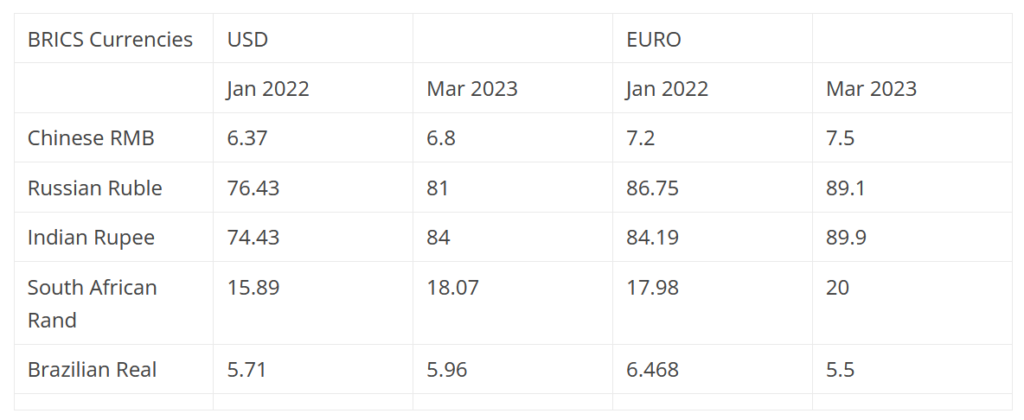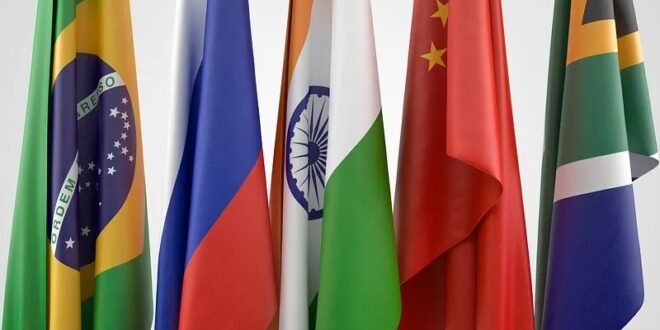For many years, the US dollar has been the official currency for international commerce. However, there has recently been discussion of developing a new currency in order to replace the dollar and challenge the dollar’s hegemony. The situation worsens in 2022, when the world witnesses an unprecedented wave of sanctions on Russia. Of course, the main reason for the embargo is the Ukraine war.
However, the attack on the Russian currency posed a danger to other non-western economies, and nations are now nearing the de-dollarization phase to avoid such a destiny. The strategy has now grown so prevalent that it might be referred to as a currency war. This de-dollarization was accelerated on March 30, 2023, when Alexander Babakov, deputy head of the State Duma, said, “The transition to settlements in national currencies is the first step. The next one is to provide the circulation of digital or any other form of a fundamentally new currency in the nearest future. I think that at the coming BRICS Summit, the readiness to realize this project will be announced. Such works are underway.”
Moving ahead, the BRICS group, comprised of Brazil, Russia, India, China, and South Africa, is obviously discussing the creation of a new currency to promote trade. BRICS member countries account for more than 40% of the world population and almost a quarter of global GDP.
In recent months, the group has positioned itself as the Global South’s alternative to the G7. As a result, the introduction of the BRICS currency would undoubtedly elevate BRICS from an economic alliance to a crucial geopolitical alliance of the twenty-first century. Furthermore, numerous countries in West Asia and North Africa, notably Saudi Arabia and Algeria, have indicated interest in joining the union. Iran formally sought to join the BRICS last year. At the same time, the prolonged global economic crisis has resulted in a clear fall in foreign reserves.
However, the strength of the US currency isn’t only a problem that can be solved overnight; rather, the power of the dollar has the potential to impede the growth of new currencies. As a result, the destiny of the world’s currencies will be decided in the next days by a “currency war.”
Why The New Currency?
The concept of introducing a new BRICS currency does not originate from void, but rather combines both economic and strategic aspects that are primarily based on the world’s recent geopolitical scenario, as well as the direct effects or aftermath of a post-pandemic, war-affected, unprecedentedly polarised world.
In terms of the economic domain, the concept of the BRICS as a new currency is not a recent development. Because, from its inception, BRICS has been extremely aggressive in promoting commerce among BRICS nations using local currencies. As a result, if the BRICS countries follow forwards with their plan and create a new currency, it may assist stabilise their economies. It would imply improve customer confidence for a BRICS investment. This would result in increased expenditure and economic development.
Second, currency weakness versus the euro and dollar has been a significant setback for BRICS nations in the recent year. Furthermore, in terms of performance in 2022, the BRICS currencies were trading as follows versus the USD and EUR:
Currency depreciation of BRICS currencies in last one year (per unit of local currency)

The US dollar has fallen in value against the Russian rouble and the Brazilian real, while the euro has fallen in value against all BRICS currencies. As a result, member nations have boosted the use of local currencies in bilateral commerce to create a secure economic environment. Furthermore, by adopting a single currency, nations might limit their susceptibility to currency volatility and interest rate changes, so improving economic stability and lowering the likelihood of financial crises.
Third, the concept of a single currency had the potential to become both a worldwide alternative to the dollar and a direct danger to the greenback. The US dollar has been referred to as the “king of currencies.” In 1944, it was designated as the world’s official reserve currency.
Since then, the dollar has had a commanding position in the global economy. It has given the United States considerable power over other economies. In truth, the United States has traditionally utilised sanctions to accomplish foreign policy objectives.
However, not everyone agrees with US regulations, and nations such as Russia and China would wish to end dollar hegemony. As a result, the process of generating new BRICS currencies refers to lowering the dominance of the dollar in global markets. Furthermore, this approach would diminish other nations’ reliance on the US currency and the US economy, perhaps mitigating the effect of economic and political developments in the US on their own economies.
Fourth, in the fourth quarter of last year, the worldwide percentage of dollar-based foreign currency reserves slipped below 59 percent, continuing a two-decade fall. Western nations, on the other hand, frozen $300 billion of Russia’s foreign currency reserves last year, about half of the total, and barred Russian banks from using the Swift international payments system. As a result, the BRICS nations have been hit by these downturns, and the drop has compelled these countries to establish a unified currency. Furthermore, the BRICS resolution suggests a strong hostility to “dollar weaponization.”
Finally, the process may be presented from many perspectives for each BRICS member state. The deterioration of US-China ties has underlined the dominance of the US currency and its capacity to stymie Chinese commerce and technology. As a result, such impediments have urged China to abandon the US-dominated global system and perhaps develop an alternative currency.
On the other hand, Brazil’s reliance on the dollar is clear, since almost 90% of Brazil’s export invoicing is denominated in dollars, despite the fact that the United States (US) gets just 17% of Brazil’s total exports. This disparity motivates Brazilian authorities to promote the establishment of a BRICS reserve currency.
Furthermore, given its geopolitical interests, Russia has long sought to use the BRICS to further the concept of de-dollarization. The near-elimination of Russia from the West-led, dollar-dominated financial system during the Russia-Ukraine conflict in early 2022 has bolstered the notion of a financial system free of Western dominance.
Moreover, the Indian government regards Russia and China’s initiatives to decrease dollar use as ideological rather than practical. Currency instability and geopolitical developments such as the United States’ oil sanctions on Russia and Iran, as well as China’s attempts to internationalise the renminbi, have spurred India to advocate broader use of the rupee for international transactions.
Therefore, India, too, has been attempting to wean itself off the dollar. 18 nations, including the United Kingdom, Germany, Russia, and even the United Arab Emirates, have just been granted authorisation to trade in Indian rupees.
Is It Possible to Overturn USD?
USD holds around 60% of worldwide foreign currency reserves and is the most common means of exchange for commerce, accounting for more than 70% of exports outside of Europe. These are only a few instances of the USD’s strength in the global economy. As a result, the BRICS countries are also reliant on the USD, which is not going away easy. For example, despite the fact that just 5% of India’s imports originate in the US, 86 percent of its imports are invoiced in US dollars. Similarly, despite just 15% of India’s exports went to the US, 86 percent of its exports were billed in US dollars.
Furthermore, the United States has maintained enormous trade deficits, resulting in an oversupply of US Treasury securities and currencies held by the rest of the globe. While nations may choose to trade in their own currencies rather than the USD, there are various obstacles to this shift. Countries such as China and Saudi Arabia, for example, would have to contend with currency constraints, a lack of acceptable investment choices, and capital restrictions.
At the moment, there is no viable alternative to the US dollar, and its dominance in the global financial environment is likely to endure for the foreseeable future. As a result, the BRICS decision is not just remarkable for a brief period of time; rather, the BRICS strategy has clearly suggested a forthcoming tweaked future of global economic order. However, the success of ‘de-dollarization’ is largely dependent on the BRICS nations’ methods and how far the alternative currency can go to repel the greenback.
To summarize, the BRICS strategy to launching a new currency indicates an evident change in global economic dynamics. However, the strategy is more than merely adorned with economic outputs and metrics; it has now evolved into a new sphere of power politics, polarization, and global economic reformation. As a result, the success or failure of such measures will undoubtedly alter the global economic landscape in the following days.
 Eurasia Press & News
Eurasia Press & News



